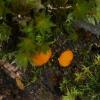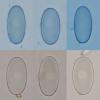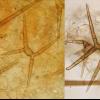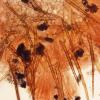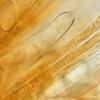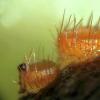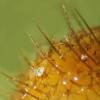
28-12-2025 12:08
Margot en Geert VullingsThis possible Karstenia was found on the bark of d

21-12-2025 21:32
Pol DebaenstHello, Garden, Burgweg 19, Veurne, BelgiumOn 10/1

26-12-2025 21:19
Arnold BüschlenPithyella chalaudii Priou. Ist als Bryoparasit in

21-12-2025 09:32
Hello.A tiny ascomycete found embedded in wood in

18-12-2025 21:17
Pol DebaenstThe identification took me to Byssonectria deformi

24-12-2025 17:08
Hulda Caroline HolteHello, I have found this propoloid ascomycete on
 Hello,
Hello,this fungus was found in Svaneti (Georgia, Caucasus), in altutitude 1470 m asl., on soil with moss.
In the first moment, I though it was Cheilymenia crucipila, but spores are smooth.
Apothecia up to 2 mm broad, sessile, orange, with brown hairs on the margin and the outer surface.
Asci 8-spored, uniseriate, non-amyloid, 225-260 x 12.5-15 micrometers.
Spores 16-19 x 8.5-9.4 micrometers, ellipsoid, smooth, with 1 nucleus (4 micrometers across), sometimes with a mucilagenous sheath.
Paraphyses straight, septate, containing orange pigment, 3.5-4.5 micrometers broad, apex up to 6 micrometers.
Excipulum consists of globose, subglobose or angular cells up to 78 micrometers long.
Lateral hairs brown, septate, up to 830 x 26.5 micrometers, mixed with stellated hairs.
Beside Cheilymenia crucipila, I considered C. stercorea f. alpina, which is, however, a typically dung-inhabiting species. There are many cow pastures near the locality, so it´s possible the place was polluted with excrements some time ago.
Other 2 species in the ser. Cheilymenia also don´t fit - C. asteropila (terrestric) has smaller spores ornamented with fine warts, C. parvispora has even smaller spores and grows on dung.
Any suggestions?
Thank you, Zuzana
in my opinion is this already Ch. stercorea f. alpina. The substrate sometimes is not to be recognized any more or it suffices only a little bit soaked ground. Macroscopically striking the long hair with the big distances on the margin.
Greetings Peter.

Best regards,
Zuzana
